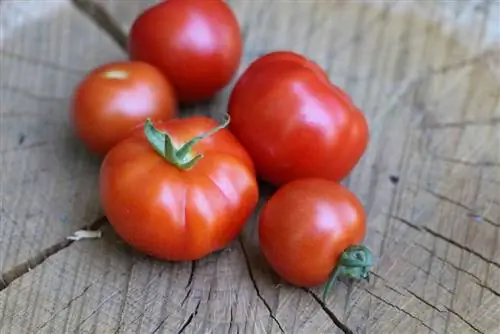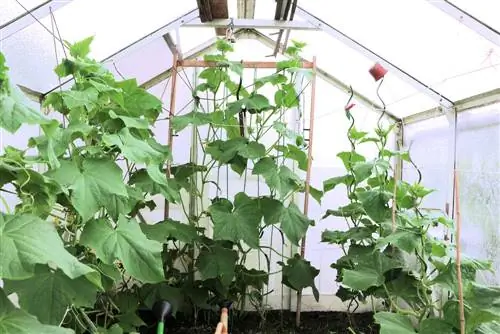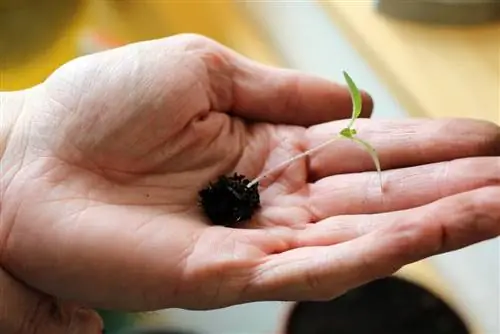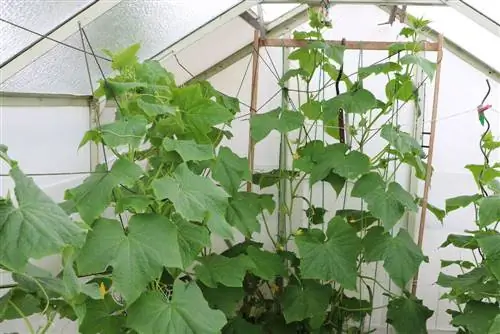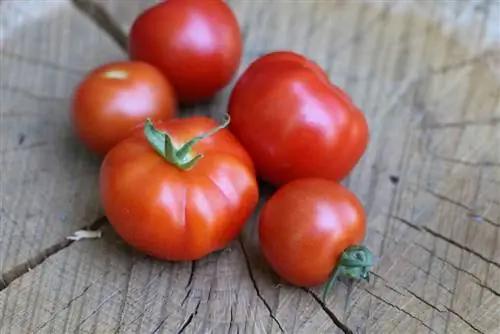- Author admin [email protected].
- Public 2023-12-17 03:39.
- Last modified 2025-01-24 12:45.
When it comes to the question of which type of cultivation is better, it is the tomato variety that makes the difference, because not every variety is suitable for every form of cultivation. But it is precisely this variety of varieties that makes it possible to grow tomatoes outdoors, in the greenhouse or on the balcony. If the local conditions are appropriate, many people prefer greenhouse cultivation. However, outdoor cultivation is also possible. There are a few basic things to consider with both. But which is better, growing outdoors or in a greenhouse?
Open field or greenhouse cultivation, which is better?
In basic things, outdoor cultivation and greenhouse cultivation are similar. In both cases, the tomato plants should be as sunny, protected and warm as possible. If you choose the wrong variety, a lot can go wrong with both. The biggest problem with these plants is moisture or wetness, especially on the leaves. This can cause the dreaded brown rot, a fungal infection that affects plants and fruits that are then no longer suitable for consumption.
Brown rot can occur both in the greenhouse and outdoors, but is much more common in the latter. Outdoor tomatoes are said to have a superior taste to those grown in the greenhouse. So-called thinning is also recommended, with the exception of bush and hanging tomatoes outdoors and in the greenhouse. Which type of cultivation is ultimately the best depends on several factors.
Growing tomatoes outdoors
With this form of cultivation, significantly more plants can be planted and therefore harvested than in a greenhouse. However, only a few varieties are robust and resilient enough to withstand the adverse conditions of outdoor cultivation. Outdoors, tomato plants are exposed to a wide variety of weather conditions. That's why you should preferably choose varieties that are naturally particularly resistant to diseases.
Damp and wet weather is particularly problematic when growing outdoors. For this reason, you should pay attention to sufficient planting distances, especially with bush tomatoes, so that the air can always circulate well between the plants.
Rain protection essential
Completely unprotected places are problematic for growing tomatoes, especially outdoors. Since outdoor tomatoes cannot be transported from one place to another as needed like potted plants, the location should be selected with great care. The most important protection for tomatoes is from rain and moisture. They are the breeding ground for the dreaded late blight.
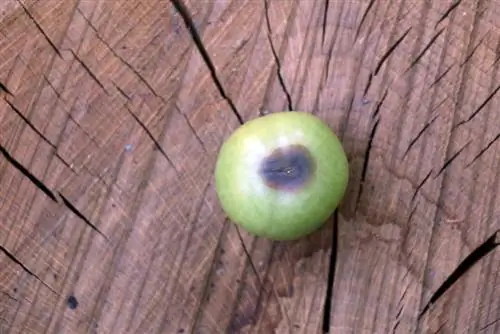
This fungal disease spreads quickly through the plants and fruits, which can lead to significant harvest losses. It becomes particularly difficult in rainy summers. This is why appropriate rain protection that protects the plants from both rain and splash water is even more important. This can be a self-built wooden structure that is open on all sides or a commercially available roof, a so-called tomato roof. Such a roof has the advantage, among other things, that it protects the plants and of course the fruits from excessive sunlight and especially from rain and hail.
Because the sides are open, the air can circulate easily between the individual plants at all times. Excess moisture is quickly removed, the leaves dry quickly and the fungi are deprived of their breeding ground. If you want to grow tomatoes in a bucket on a balcony or terrace, it is best to place them on a warm and, above all, covered house wall.
Tip:
Such a flexible tomato roof is by no means intended to be used exclusively for tomatoes. It can also provide protection for other plants, which may then thrive better.
Harden off before planting
- Put young plants outside to harden off before planting out
- Outside temperatures should be at least 12 to 15 degrees
- Then only take the young plants outside for a few hours during the day
- Place preferably in a partially shaded and wind-protected place
- Under no circumstances in the blazing sun, it would burn the young leaves
- After a few days, they get used to the new conditions
- Now slowly get a little sunnier
- Plant in your final location from mid/end of May, depending on the weather
Harvest before the first frost
The ripening period of outdoor tomatoes begins around June, depending on the variety and weather conditions. In contrast to greenhouse cultivation, the harvest of outdoor tomatoes should be completed in October. Usually not all of the fruits are ripe at this point, either due to insufficient heat and sunlight or generally due to unfavorable weather conditions. However, the fruits that are still green do not have to be thrown away. They can also be harvested and left to ripen in a cool, dark room. However, the taste and quality of the fruit suffer.
Growing in a greenhouse
Growing tomatoes in a greenhouse also has advantages and disadvantages. Here the plants are protected from all weather influences; cold, strong winds and rain cannot harm them. The risk of late blight or brown rot infestation is significantly lower here. The young tomato plants can be planted at the end of April, which is significantly earlier than when grown outdoors. Thanks to the warm climate, they grow faster and often ripen a little earlier. The tomatoes can remain on the plants until they are fully ripe, as there is no danger of frost, provided the greenhouse is frost-proof.
Tip:
There is a special feature when fertilizing: In contrast to outdoor tomatoes, the fertilizer for crops in the greenhouse should only contain a little nitrogen, regardless of the respective variety.
Limited space
- The usable area in greenhouses is usually very limited
- Especially when growing different types of vegetables at the same time
- Tomatoes alone require a relatively large amount of space for optimal growth
- In addition, sufficient planting distances must be maintained
- That's why thinning out tomato plants is essential, even in the greenhouse
- Mainly remove the side shoots
- This reduces the growth in width and promotes height growth
- Paying attention to suitable varieties is therefore even more important
Not every variety is suitable
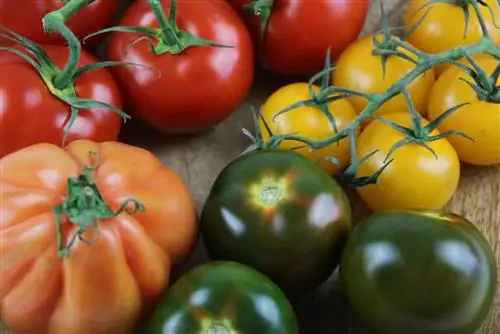
Tall varieties are particularly suitable for cultivation in the greenhouse, such as the red bottle tomato 'San-Marzano', the beefsteak tomato 'Tigerella', the F1 hybrids 'Dolcevita' and 'Pannovy' as well as the yellow cocktail tomato ' Yellow Pearshaped'. These varieties can be grown very well on long supports. They require significantly less floor space, which is an advantage given the limited space available in conventional greenhouses. On the other hand, vigorous bush or vine tomatoes are less suitable.
Demands on the greenhouse
Greenhouses come in a wide variety of sizes and features. These can be massive greenhouses or a simple foil tent. Ideally, it is large enough for several plants, has a translucent roof and is bright and warm inside. No less important are sufficient ventilation options so that the leaves can dry quickly, as well as the possibility of shading against intense sunlight in summer.
In greenhouses there is usually a high level of humidity, which on the one hand benefits the tomatoes, but which can also harm them if excessive moisture cannot escape. Therefore, good ventilation should always be ensured and ventilated daily. If the moist air cannot escape, condensation forms on the ceiling and walls, which constantly drips onto the plants and can lead to rot. Foil tents sold in stores must also be protected from strong winds, but should still be placed in a sunny place. Non-heatable film greenhouses have the disadvantage that they do not offer any protection against frost.
Avoid temperature fluctuations
- Young plants exposed to strong temperature fluctuations in the greenhouse in spring
- Tomatoes prefer constant temperatures between 20 and 30 degrees
- Nights in spring are still very cold, sometimes even frosty
- At midday temperatures can rise to 30 degrees
- Severe temperature fluctuations can cause stress cracks in the stems
- The remedy is regular and well-dosed ventilation
- Optimal ventilation can prevent temperature-related damage
Help needed with fertilization
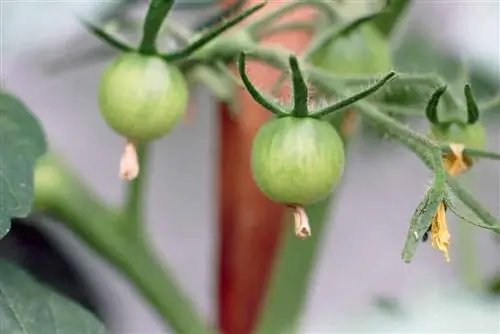
A big issue is the pollination of plants, which are taken over by numerous insects or the wind in the garden. You have to help a little in the greenhouse. This gives you the opportunity to gently shake the plants again and again during flowering so that the flowers release their pollen. Or you can leave the windows or doors open during the day so that insects can fly in and pollinate the flowers. Please do not leave doors and windows open at the same time, the draft would not be beneficial.
Tip:
Temperature also plays a crucial role in pollination, because at temperatures above 30 degrees the pollen sticks together so that fertilization is not possible.
Conclusion
It cannot be said clearly whether growing tomatoes outdoors or in a greenhouse is better. Which cultivation variant you ultimately choose depends on various factors. The biggest advantage of growing in a greenhouse is that the plants are protected from all adverse weather conditions. Outdoor tomatoes, on the other hand, are said to be tastier and more aromatic. Tomatoes thrive well protected both outside and under glass or foil, as long as you ensure the best possible protection from rain and the right varieties.

